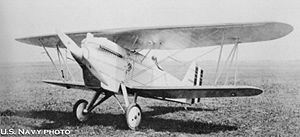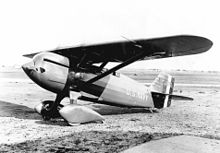Curtiss F6C Hawk
| F6C Hawk | |
|---|---|

| |
| Curtiss F6C-1 - Model 34 | |
| Role | Carrierborne Fighter & Land-based Fighter |
| Manufacturer | Curtiss Aeroplane and Motor Company |
| Introduction | 1925 |
| Primary users | United States Navy United States Marine Corps |
| Produced | 1927 |
| Number built | 75 |
The Curtiss F6C Hawk was a late 1920s American naval biplane fighter aircraft. It was part of the long line of Curtiss Hawk airplanes built by the Curtiss Aeroplane and Motor Company for the American military.
Originally designed for land-based use, the Model 34C was virtually identical to the P-1 Hawk in United States Army Air Corps service. The United States Navy ordered nine, but as the sixth example was built it was strengthened for carrier-borne operations and redesignated as the Model 34D. Flown from the carriers Langley and Lexington from 1927–1930, most of the later variants passed to Marine fighter-bomber units, while a few were flown for a time as twin-float seaplanes.
Operators
Variants


- F6C-1 Model 34C virtually identical to the P-1 series.
- F6C-2 Model 34D strengthened for carrierborne operations and fitted with arrester hooks.
- F6C-3 Model 34E modified version of the F6C-2.
- XF6C-4 Model 34H prototype F6C-1 with a Pratt & Whitney R-1340 Wasp radial engine.
- F6C-4 Model 34H production version of the XF6C-4.
- XF6C-5 Model 34H prototype F6C-1 with a Pratt & Whitney R-1690 Hornet radial of 525 hp (391 kW).
- F6C-6 Model 34E modified for racing, with its radiator located inside the fuselage.
- XF6C-6 Model 34E the F6C-6 which had won the 1930 Curtiss Marine Trophy was converted to parasol-wing monoplane configuration and given wing surface radiators; after achieving the fastest lap in the 1930 Thompson Trophy race the XF6C-6 crashed when its pilot was overcome by fumes.
- XF6C-7 Model 34H testbed for an experimental 350 hp (260 kW) Ranger SGV-770C-1 air-cooled inverted Vee engine.
Specifications (F6C-4)
Data from United States Navy Aircraft since 1911[1]
General characteristics
- Crew: 1
Performance
- Climb to 5,000 ft (1,520 m): 2.5 min
Armament
- Guns: 2 × fixed .30 in (7.62 mm) Browning machine guns in the forward fuselage
See also
Related development
References
- Eden, Paul and Soph Moeng. The complete Encyclopedia of World Aircraft. London:Amber Books, 2002.
- Swanborough, Gordon and Peter M. Bowers. United States Navy Aircraft since 1911. London:Putnam, Second edition, 1976. ISBN 0-370-10054-9.
